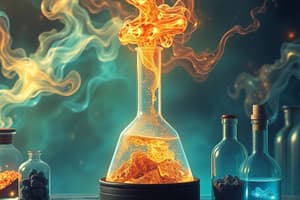Podcast
Questions and Answers
Which of the following is NOT included in a lab order?
Which of the following is NOT included in a lab order?
- Diagnosis code (ICD-10-CM)
- Signature of the ordering licensed provider
- Patient's name and date of birth (correct)
- Test names (CPT codes)
What types of specimens are typically needed to perform tests?
What types of specimens are typically needed to perform tests?
- Blood only
- Nasopharygeal and blood
- Urine and stool only
- Blood, urine, and stool (correct)
Where can you find handling, collecting, and processing information for each test?
Where can you find handling, collecting, and processing information for each test?
- In the lab order
- In the lab requisition form
- In the patient's chart
- In the Test Directory (correct)
Which step should be done before the blood draw begins?
Which step should be done before the blood draw begins?
What should be done after the specimens are drawn?
What should be done after the specimens are drawn?
What does the lab test directory provide?
What does the lab test directory provide?
What is the minimum amount of serum yielded from a gold tube containing 5mL of blood?
What is the minimum amount of serum yielded from a gold tube containing 5mL of blood?
Which type of tube is used for tests that require serum?
Which type of tube is used for tests that require serum?
Which type of tube is typically used for bleeding time tests?
Which type of tube is typically used for bleeding time tests?
What is the purpose of centrifugation in the blood processing procedure?
What is the purpose of centrifugation in the blood processing procedure?
Why is it important to perform inversions quickly when using anticoagulant tubes?
Why is it important to perform inversions quickly when using anticoagulant tubes?
Every blood draw should have a plan for success created and individualized to that ______.
Every blood draw should have a plan for success created and individualized to that ______.
The lab order contains test names (CPT codes) and corresponding diagnosis code (ICD-10-CM) and must be signed by ordering licensed ______.
The lab order contains test names (CPT codes) and corresponding diagnosis code (ICD-10-CM) and must be signed by ordering licensed ______.
The Laboratory Test Directory provides all of the handling, collecting and processing ______ for each test.
The Laboratory Test Directory provides all of the handling, collecting and processing ______ for each test.
Clot activator tubes (Gold, Tiger-top, some red tubes) which yield serum must be given time to ______.
Clot activator tubes (Gold, Tiger-top, some red tubes) which yield serum must be given time to ______.
After 30 mins, the tube should be 'spun down' by running them in a ______ for 10 minutes.
After 30 mins, the tube should be 'spun down' by running them in a ______ for 10 minutes.
Anticoagulant tubes may yield ______ or plasma.
Anticoagulant tubes may yield ______ or plasma.
The 'Whole Blood' tubes, also having anticoagulant additives, contain EDTA, and can be tested right away. These are not to be ______, as the desire is to test the blood 'as a whole'.
The 'Whole Blood' tubes, also having anticoagulant additives, contain EDTA, and can be tested right away. These are not to be ______, as the desire is to test the blood 'as a whole'.
Before drawing blood, it is important to check the expiration date of the ______ used
Before drawing blood, it is important to check the expiration date of the ______ used
The lab test directory provides information about the ______ and processing requirements for each test
The lab test directory provides information about the ______ and processing requirements for each test
To determine the minimum amount of blood component needed for tests using the same colored vacutainer, you should ______ the minimum amounts of the blood component together
To determine the minimum amount of blood component needed for tests using the same colored vacutainer, you should ______ the minimum amounts of the blood component together
In order to ensure specimen viability, it is important to label the specimens ______ and clean the draw area after the draw
In order to ensure specimen viability, it is important to label the specimens ______ and clean the draw area after the draw
Match the following document types with their descriptions:
Match the following document types with their descriptions:
Match the types of specimens with their corresponding tests in the course:
Match the types of specimens with their corresponding tests in the course:
Match the following terms with their definitions:
Match the following terms with their definitions:
Match the following tube types with their specific requirements or characteristics:
Match the following tube types with their specific requirements or characteristics:
Match the following tube colors with their results after centrifugation:
Match the following tube colors with their results after centrifugation:
Match the following steps with their corresponding procedures in the lab:
Match the following steps with their corresponding procedures in the lab:
Match the following procedures with their purposes:
Match the following procedures with their purposes:
Match the following steps with their respective stages in the blood test process:
Match the following steps with their respective stages in the blood test process:
Match the following considerations with their respective stages in the blood test process:
Match the following considerations with their respective stages in the blood test process:
Match the following actions with their respective stages in the blood test process:
Match the following actions with their respective stages in the blood test process:
Match the following steps with their respective stages in the blood test process:
Match the following steps with their respective stages in the blood test process:
True or false: Specimen handling and processing requirements must be initiated before the blood draw begins.
True or false: Specimen handling and processing requirements must be initiated before the blood draw begins.
True or false: Specimen viability may be lost if blood is drawn before finding out important information about the patient and the test requirements.
True or false: Specimen viability may be lost if blood is drawn before finding out important information about the patient and the test requirements.
True or false: The lab test directory provides information about the color of tube required, tube-fill requirements, storage and transportation requirements, and minimum blood component volume needed for testing.
True or false: The lab test directory provides information about the color of tube required, tube-fill requirements, storage and transportation requirements, and minimum blood component volume needed for testing.
True or false: Clot activator tubes must be centrifuged for at least 30 minutes before use?
True or false: Clot activator tubes must be centrifuged for at least 30 minutes before use?
True or false: Anticoagulant tubes containing plasma can be centrifuged right away?
True or false: Anticoagulant tubes containing plasma can be centrifuged right away?
True or false: Light blue tubes are typically used for whole blood tests?
True or false: Light blue tubes are typically used for whole blood tests?
True or false: Inversions should be performed quickly when using anticoagulant tubes to prevent clotting?
True or false: Inversions should be performed quickly when using anticoagulant tubes to prevent clotting?
Flashcards are hidden until you start studying




